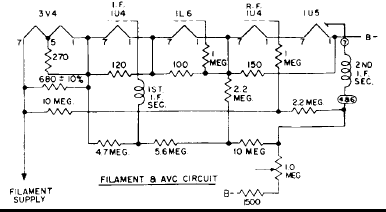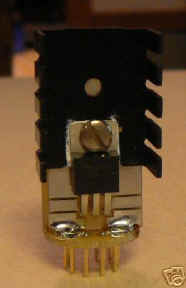|
Evaluation of a solid state (SS) 50A1
with the 1L6
Line meter - Fluke 8022B
DC meter - Extech 22-816
Radio - Restored Transoceanic chassis 6A40 (see
here for the chassis).
For Schematic
click this link
Original/used 1L6 and SS 50A1
| Line input (Vac) |
Measured DC across 700 (680) ohm R3 filament series
resistor. (Vdc) |
Calculated current
(ma) |
1L6 filament voltage across Pins 1 and 7
(Vdc) |
Local Oscillator active on 18.2MHz |
| 90.0 |
34.09 |
50.1 |
1.01 |
No |
| 95.1 |
34.09 |
50.1 |
1.04 |
No |
| 100.0 |
34.09 |
50.1 |
1.05 |
No |
| 105.0 |
34.09 |
50.1 |
1.08 |
No |
| 110.0 |
34.06 |
50.1 |
1.09 |
No |
| 115.1 |
34.06 |
50.1 |
1.10 |
No |
| 120.0 |
34.06 |
50.1 |
1.12 |
No |
|
Table 1 |
New 1L6 and SS 50A1
| Line input (Vac) |
1L6 filaments voltage
(Vdc) |
Local Oscillator active on 18.2MHz |
| 88.2 (below spec) |
1.11 |
No |
| 90 |
1.12 |
Yes |
| 100 |
1.18 |
Yes |
| 110 |
1.21 |
Yes |
| 115 |
1.22 |
Yes |
| 117 |
1.23 |
Yes |
|
Table 2 |
Sylvania Tube manual cut sheet.
 The Original 50A1 operated above 50ma from 59 to 54 ma for different voltages.
The Original 50A1 operated above 50ma from 59 to 54 ma for different voltages.
Current through the 1L6
 |
 |
|
There is a 100 ohm resistor parallel to the filament Pins 1 and 7 that
divides the filament current. Using ohm's law I=E/R the current
through the 100 ohm resistor is 1.09v/100ohm = 10.9 ma. That leaves
only 39.1 ma for the tube filament. Also the tube filament is rated
at 1.4 volts. A bit more current from the regulator would help to
boost the 1L6 filament voltage. This should help the tube oscillate
at the higher frequencies around 18 MHz.
The objective is to get 1.3 to 1.4 volts on the used 1L6 filament at the top
end of the line voltage input. Since the SS 50A1 has fantastic
regulation, as reported in Table 1, a bit more current allowed into
the filament string should improve performance. As it turns out, below, a fresh
NOS 1L6 and the solid state 50A1 perform
just fine. No drop out of the oscillator on the high short wave band
at 18MHz. However, I would like
|
Additional data
These results are for the fresh new 1L6 and a fresh new 50A1 (D5TF30) ballast tube.
| Line input (Vac) |
Measured DC across 700 (680) ohm R3 filament series
resistor. (Vdc) |
Calculated current
(ma) |
Measured 1L6 filament voltage across Pins 1 and 7
D5TF30
(Vdc) |
Local Oscillator active on 18.2MHz |
| 71 (below spec) |
-- |
-- |
-- |
No |
| 90 |
33.7 |
.050 |
1.11 |
yes |
| 95 |
34.1 |
.050 |
1.18 |
yes |
| 100 |
34.6 |
.051 |
1.29 |
yes |
| 105 |
35.0 |
.051 |
1.29 |
yes |
| 110 |
35.4 |
.052 |
1.36 |
yes |
| 115 |
35.8 |
.053 |
1.41 |
yes |
| 117 |
35.9 |
.053 |
1.44 |
yes |
| 120 |
36.3 |
.053 |
1.49 |
yes |
| 125 |
36.8 |
.054 |
1.57 |
yes |
|
Table 3 |
Solid State 50A1 and fresh New 1L6
| Line input (Vac) |
Measured DC across 700 (680) ohm R3 filament series
resistor. (Vdc) |
Calculated current
(ma) |
Measured 1L6 filament voltage across Pins 1 and 7
SS50A1
(Vdc) |
Local Oscillator active on 18.2MHz |
| 90 |
34.08 |
.050 |
1.16 |
yes |
| 95 |
34.08 |
.050 |
1.185 |
yes |
| 100 |
34.08 |
.050 |
1.20 |
yes |
| 105 |
34.08 |
.050 |
1.22 |
yes |
| 110 |
34.08 |
.050 |
1.24 |
yes |
| 115 |
34.08 |
.050 |
1.25 |
yes |
| 117 |
34.08 |
.050 |
1.25 |
yes |
| 120 |
34.07 |
.050 |
1.27 |
yes |
| 125 |
34.07 |
.050 |
1.29 |
yes |
|
Table 4 |
Conclusions:
The used 1L6 needs a bit more filament voltage, closer to the tube
specification of 1.4 volts, to function on the high shortwave band of 18 MHz.
The solid state 50A1 holds the current constant at a lower filament voltage than
the used tube desires to oscillate on the high SW band. It oscillates
with increased filament voltage (observed but not documented).
The new D5TF30 (50A1) ballast tube has a current range from 50 ma to 54
ma.
It appears that a new 1L6 works with reduced filament voltage on all bands
and all frequencies with the new D5TF30 ballast tube and the solid state 50A1 ballast
tube.
The solid state ballast tube works great with the fresh new 1L6 and has rock
solid current regulation.

I have been in contact with the seller of these solid state
replacements. Ed is a courteous gentleman and has provided the following correspondence
to be shared:
Hello Paul,
There is a chip resistor that set the current to about 50mA and a
1/4 watt axial resistor that is a trim that is selected in test to
set the current between 50mA and 51 mA. On most devices this
resistor is 1K. Current increase is about 1.2 / R Amps. Thus, if you
reduce this resistor from 1K to 510 Ohm you will increase current by
about 1.2 mA, 330 ohms will increase it to about 2.4 mA, 220 Ohms
will increase it about 4.3 mA, etc.
I hope this helps,
Ed
|
|
|

|

|
